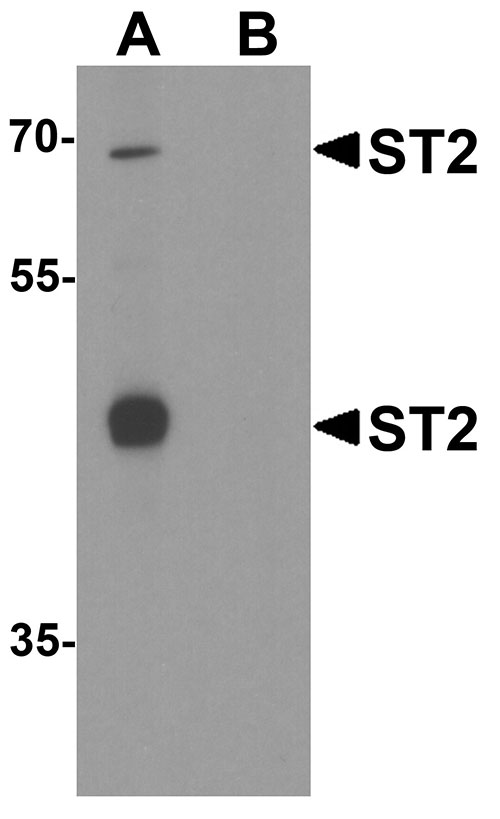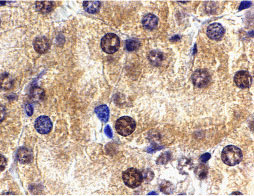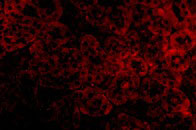ST2 Antibody
- 产品详情
- 实验流程
- 背景知识
Application
| WB, IF, E, IHC-P |
|---|---|
| Primary Accession | P14719 |
| Other Accession | BAA02854, 286101 |
| Reactivity | Human, Mouse |
| Host | Rabbit |
| Clonality | Polyclonal |
| Isotype | IgG |
| Calculated MW | 64801 Da |
| Concentration (mg/ml) | 1 mg/mL |
| Conjugate | Unconjugated |
| Application Notes | ST2 antibody can be used for the detection of ST2 by Western blot at 1 µg/mL. Antibody can also be used for immunohistochemistry starting at 2 µg/mL. For immunofluorescence start at 20 µg/mL. |
| Gene ID | 17082 |
|---|---|
| Other Names | ST2 Antibody: T1, St2, DER4, Ly84, ST2L, Fit-1, T1/ST2, St2-rs1, Ste2, Interleukin-1 receptor-like 1, Lymphocyte antigen 84, interleukin 1 receptor-like 1 |
| Target/Specificity | Il1rl1; |
| Reconstitution & Storage | ST2 antibody can be stored at 4℃ for three months and -20℃, stable for up to one year. As with all antibodies care should be taken to avoid repeated freeze thaw cycles. Antibodies should not be exposed to prolonged high temperatures. |
| Precautions | ST2 Antibody is for research use only and not for use in diagnostic or therapeutic procedures. |
| Name | Il1rl1 |
|---|---|
| Synonyms | Ly84, St2, Ste2 |
| Function | Receptor for interleukin-33 (IL-33) which plays crucial roles in innate and adaptive immunity, contributing to tissue homeostasis and responses to environmental stresses together with coreceptor IL1RAP (PubMed:17675517, PubMed:18450470, PubMed:22660580, PubMed:29045903). Its stimulation recruits MYD88, IRAK1, IRAK4, and TRAF6, followed by phosphorylation of MAPK3/ERK1 and/or MAPK1/ERK2, MAPK14, and MAPK8 (By similarity). Possibly involved in helper T-cell function (By similarity). Upon tissue injury, induces UCP2-dependent mitochondrial rewiring that attenuates the generation of reactive oxygen species and preserves the integrity of Krebs cycle required for persistent production of itaconate and subsequent GATA3-dependent differentiation of inflammation-resolving alternatively activated macrophages (PubMed:34644537). |
| Cellular Location | Cell membrane; Single-pass type I membrane protein |
| Tissue Location | Predominantly expressed in hematopoietic tissues, and in macrophage, erythroid, epithelial and fibroblast cell lines Isoform A is expressed in brain astrocytes and microglia. Isoform B is expressed in brain endothelial cells. |
For Research Use Only. Not For Use In Diagnostic Procedures.
Provided below are standard protocols that you may find useful for product applications.
BACKGROUND
ST2 Antibody: ST2 is a member of a superfamily containing the interleukin-1 receptor and the Toll-like receptors (TLRs). The TLRs are signaling molecules that recognize different microbial products during infection and serve as an important link between the innate and adaptive immune responses. ST2 was originally identified as a protein whose production was stimulated by various proliferation-inducing agents such as PDGF and FGF. More recently, it has been shown to negatively regulate IL-1 receptor and Toll-like receptor (TLR) 4 signaling and to maintain endotoxin tolerance. It has been suggested that the inhibition of TLR4 signaling occurs through the association and sequestering of TLR adaptor molecules such as MyD88 and TIRAP.
REFERENCES
Takeda K, Kaisho T, and Akira S. Toll-like receptors. Annu. Rev. Immunol. 2003; 21:335-76.
Janeway CA Jr. and Medzhitov R. Innate immune recognition. Annu. Rev. Immunol. 2002; 20:197-216.
Lanahan A, Williams JB, Sanders LK, et al. Growth factor-induced delayed early response genes. Mol Cell Biol. 1992; 12:3919-29.
Sweet MJ, Leung BP, Kang D, et al. A novel pathway regulating lipopolysaccharide-induced shock by ST2/T1 via inhibition of Toll-like receptor 4 expression. J. Immunol. 2001; 166:6633-9.
终于等到您。ABCEPTA(百远生物)抗体产品。
点击下方“我要评价 ”按钮提交您的反馈信息,您的反馈和评价是我们最宝贵的财富之一,
我们将在1-3个工作日内处理您的反馈信息。
如有疑问,联系:0512-88856768 tech-china@abcepta.com.























 癌症的基本特征包括细胞增殖、血管生成、迁移、凋亡逃避机制和细胞永生等。找到癌症发生过程中这些通路的关键标记物和对应的抗体用于检测至关重要。
癌症的基本特征包括细胞增殖、血管生成、迁移、凋亡逃避机制和细胞永生等。找到癌症发生过程中这些通路的关键标记物和对应的抗体用于检测至关重要。 为您推荐一个泛素化位点预测神器——泛素化分析工具,可以为您的蛋白的泛素化位点作出预测和评分。
为您推荐一个泛素化位点预测神器——泛素化分析工具,可以为您的蛋白的泛素化位点作出预测和评分。 细胞自噬受体图形绘图工具为你的蛋白的细胞受体结合位点作出预测和评分,识别结合到自噬通路中的蛋白是非常重要的,便于让我们理解自噬在正常生理、病理过程中的作用,如发育、细胞分化、神经退化性疾病、压力条件下、感染和癌症。
细胞自噬受体图形绘图工具为你的蛋白的细胞受体结合位点作出预测和评分,识别结合到自噬通路中的蛋白是非常重要的,便于让我们理解自噬在正常生理、病理过程中的作用,如发育、细胞分化、神经退化性疾病、压力条件下、感染和癌症。








